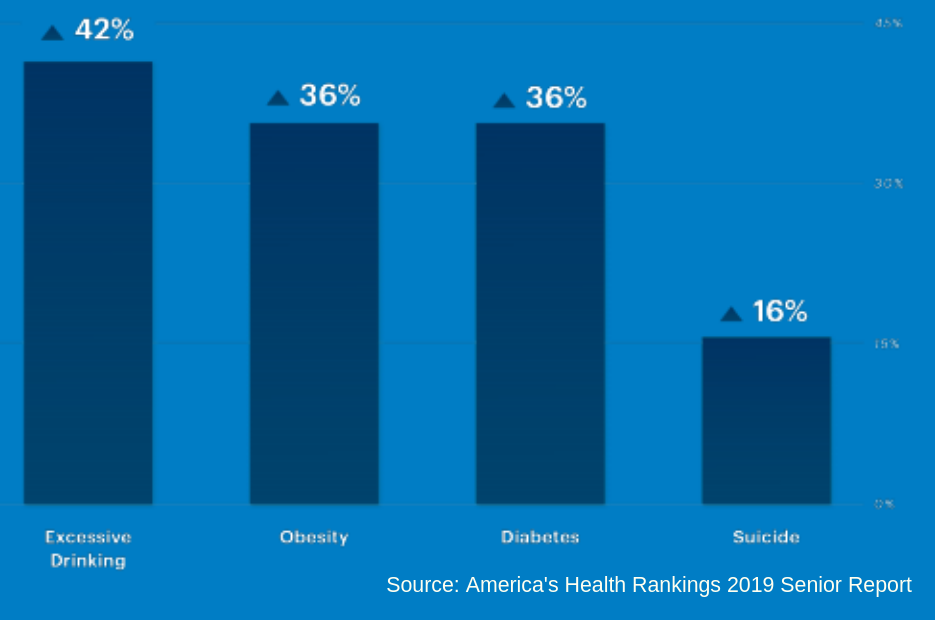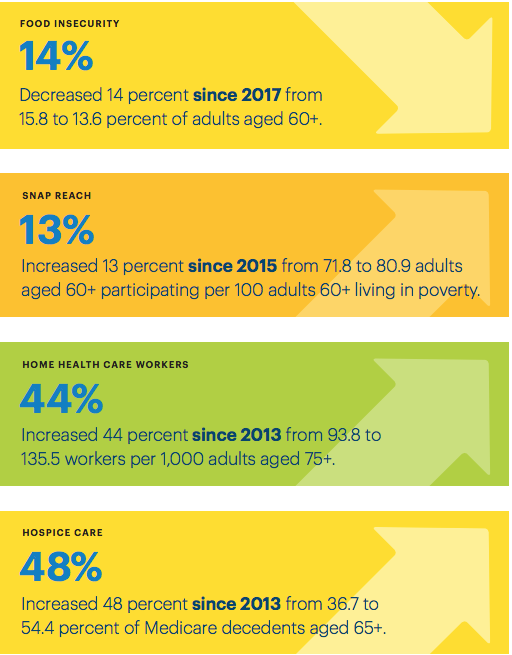Are you willing to make a few lifestyle changes to live a longer, healthier life?
 Sadly, too many senior adults today are engaging in unhealthy behaviors, and they’re paying a high price in terms of poor health.
Sadly, too many senior adults today are engaging in unhealthy behaviors, and they’re paying a high price in terms of poor health.
This is one conclusion readers can draw from the new 2019 Senior Report from America’s Health Rankings, a highly respected study produced by the United Health Foundation in partnership with the Gerontological Advanced Practice Nurses Association (GAPNA).
Seniors Engaging in Risky Behaviors
The health of senior adults in the United States has improved over the past 15 years in some key aspects, but at the same time there’s been an alarming rise in the percentage of “young seniors” (defined as those ages 65 to 74) engaging in certain unhealthy behaviors.
On a positive note, smoking has decreased 16 percent among those age 65-74 during the past 15 years (2002 to 2017), although the rate of smoking has remained about the same during the past six years.
Some other findings in the Senior Report are not such good news. Excessive drinking, obesity, diabetes, and suicide are all up among seniors ages 65 to 74 — and by significant amounts.
Excessive drinking rose the most, up 42 percent among seniors during the 15-year period. Excessive drinking is defined as either binge drinking or chronic drinking. AHR’s Senior Report says 9.1 percent of seniors practice excessive drinking today, compared with 6.4 percent 15 years ago. In other words, nearly one out of 10 seniors is a problem drinker.
The report notes that seniors have the highest alcohol-related death rate and that alcohol use contributes to “injuries, chronic diseases, dimentia, and mood disorders” among seniors. The problem of excessive drinking isn’t getting better, says the report. In just the past three years, excessive drinking among seniors has increased 12 percent.
Obesity increased 36 percent among seniors during the past 15 years, according to the 2019 Senior Report. Obese seniors are defined as those reporting a body mass index of 30.0 or higher in height and weight. The report notes that “obesity contributes significantly to early death, diabetes, cognitive decline and certain cancers.” Just in the past six years, obesity among seniors has increased 13 percent. Today, more than one out of every four senior adults in the U.S. is obese.
“Obesity contributes significantly to early death, diabetes, cognitive decline and certain cancers”
Yet another negative trend is that diabetes among seniors ages 65 to 74 increased 36 percent during the past 15 years. More than 6.8 million seniors report having disabetes, which is more than double the number from 15 years ago. The prevalence of diabetes increased from 16.9 percent to 22.9 percent of seniors ages 65 to 74 during the study period.
Suicide is up 16 percent among seniors during the past 15 years, according to the report. Nearly all of that increase came among women, whose rate of suicide increased 51 percent.
Suicide wasn’t the only health or behavior issue to show a significant gender disparity among seniors. Women reported 1.3 times as much “mental distress” and 1.5 times as much depression as men. Senior women were 1.2 times more likely to not get enough physical activity. Senior men, on the other hand, were 1.6 times more likely to be excessive drinkers and 1.3 times more likely to smoke. Men also commit suicide 6.0 times more often than women.

Positive health trends
Not all of the news is bad. The death rate among seniors ages 65 to 74 decreased 22 percent during the past 15 years. Those reporting their health as “very good” or “excellent” increased 11 percent, which the report says equates to an additional five million senior adults who say their health is very good or excellent.
Other key findings point to national successes in improving overall health and living standards for seniors in the U.S. The chart below, reprinted by permission from the report, shows some of the positive indicators.

Challenges Ahead
Seniors still face healthcare challenges, which the report says include “mental health, unhealthy behaviors and not visiting a doctor when needed due to cost.” Among the challenges are depression, which 16 percent of all adults over age 65 say is a problem. Depression among seniors is increasing, up 19 percent since the 2018 report.
Yet another challenge is that some seniors cannot afford healthcare. The Senior Report found that 5.2 percent of American seniors had failed to consult a doctor for a health problem within the past year due to cost.
Which States Are Healthiest?
The AHR’s 2019 Senior Report also provided rankings of all states to determine which states are the healthiest (or not) for seniors. We shared those findings in a separate blog post that you may read here: Healthiest States for Senior Adults.
Want better health?
Interested in more stories about health and wellness for senior adults? Check out these recent stories from This Retirement Life:
7 Functional Fitness Exercises for Seniors
How to Select a Senior-Friendly Bike
E-Bikes Allow Seniors to Enjoy Cycling and Keep Fit
Do you have comments to share about this story? We’d love to hear from you. Scroll down to add your comments below.
Note to readers: Some of the links on thisretirementlife.com are affiliate links from which we receive a small commission from sales of certain items, at no extra cost to you. As an Amazon Associate and a participant in other affiliate marketing programs, we earn from qualifying purchases. These commissions help support this blog so we can continue providing timely and useful information about living life to the fullest during the retirement years. See the full disclosure statement here.
Love this story? Sign up below to receive future blog post from This Retirement Life, sent to your email box, free of charge.








